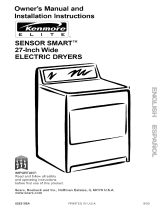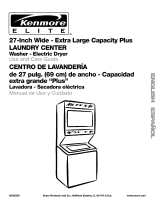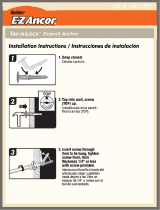
Before you begin...
Please read these instructions all the
way through.
'_ screwdriver screwdriver
j 5ocket Level
A You need these tools to
install your Kenmore Laundry
® Center. Getthem together in
one place to keep track of
them.
B Check the where are
spot
you
going to install the Laundry
®Center. Proper installation is
your responsibility. Make
sure you have everything
necessary for proper
installation.
You will need to meet
State code/law requirements: Some
Codes keep from or limit installation of
clothes dryers in residential garages,
closets, mobile homes and sleeping
quarters. (Check with your local building
inspector.)
Important: Observe all governing
codes and ordinances.
Location
Size: Must be large enough to fully open
dryer door. For recessed or closet
installations see Page 5 for spacing; for
product dimensions see the last page of these
instructions.
Support: The floor must be able to support
the appliance loaded weight of 500 pounds.
Level Floor: Maximum floor slope under
Laundry Center is 1 inch.
Protection from the weather:
Proper operation of dryer cycles requires
temperatures above 45°F. As some water
remains in the washer, do not store or
operate the washer below 32°R For
storage below 32°F. see Use and Care
Guide for "Winterizing."
_ It is the personal responsibility of
the customer to ensure that gasoline,
paint, thinners and other flammable
materials are not used or stored near the
Laundry Center. Fumes from these
materials could result in fire, explosion
or personal injury.
_Never install the Laundry Center up
against draperies or curtains and be sure
to keep any and all items from failing or
collecting behind the Laundry Center.
_ Replace all access or service panels
before operating Laundry Center.
Recommended
grounding instructions
Electrical ground is required
on this appliance.
This appliance must be grounded. In the
event of malfunction or breakdown,
grounding will reduce the risk of electric
shock by providing a path of least
resistance for electric current.
Improper connection of
the equipment-grounding conductor
can result in a risk of electric shock. Check
with a qualified electrician or serviceman
if you are in doubt as to whether the
appliance is properly grounded.
Electrical requirements
1. A S-wire single phase 120/240 volt
60Hz AC only electrical supply (or 3-
wire 120/208 volt if specified on
nameplate) is required on a separate
30 ampere circuit, fused on both
sides of the line (time-delay fuse or
circuit breaker is recommended). Do
not have a fuse in the neutral or
ground circuit.
Ifa power supply cord is used, it must
be a 30 amp rated flexible type with
three open end spade lug connectors
with upturned ends or closed loop
terminal connectors. A U.h
recognized strain relief (U.L mark on
it or Sears Part No. 687000) to fit a
one inch hole must be used. When
local codes permit, it must be plugged
into a mating 30 amp receptacle
(NEMA) type 10-30R. See Figure 1.
Figure 1
3-wire receptacle
(10-30R)
The appliance may be connected
directly to the fused disconnect (or
circuit breaker) box through flexible
armored or nonmetallic sheathed 10
gauge COPPER cable, DO NOT USE
ALUMINUM WIRE. It is the personal
responsibility and obligation of the
customer to contact a qualified
installer to assure that the electrical
installation is adequate and is in
conformance with the National
Electrical Code and local codes and
ordinances. A U.L recognized strain
4.
relief must be provided at each end
of the power supply cable (at the
appliance and at the junction box).
Wire sizes (10 gauge COPPER WIRE
ONLY) and connection must conform
with the rating of the appliance (30
amperes).
DO NOT USE AN EXTENSION CORD.
For mobile home
installation, the appliance frame must
not be connected to the neutral
terminal, but must be connected to
the ground cord (see Page 6,
Alternate Electrical Connection, for
detailed instructions).
Figure 2
4-wire receptacle
(14-30R)
Typical 30 Amp receptacle use:
Use where local codes permit flexible
type supply cord (pigtail).
If a 4-wire single phase 120/240 volt
60Hz AC receptacle of NEMA type 14-
30R (see Figure 2) is available, a matching
power supply cord (pigtail) must be used.
This cord contains 4 No. 10 gauge copper
conductors with spade or ring terminals
on the Laundry Center end and
terminating in a NEMA type 14-30P plug
on supply end. The fourth (grounding)
conductor must be identified by a green
cover and the neutral conductor by a
white cover. Cord should be type SRD or
SRDT, with a U.L. recognized strain relief,
and be at least 3 feet and no more than
6 feet long. The 4-wire power supply
cord and strain relief are not provided
with the Laundry Center.
NOTE: Laundry Center dryers operating
on 208 volt power supply will have longer
drying times than dryers operating on
240 volt power supply.
Exhaust requirements
Use only 4 inch (10.16 cm) diameter
(minimum) rigid or flexible metal duct
and approved vent hood which has a
swing-out damper(s) that opens when
the dryer is in operation. When the dryer
stops, the damper(s) automatically closes
to prevent drafts and the entrance of
insects and rodents. To avoid restricting
the outlet, maintain a minimum of 12
inches (38.5 cm) clearance between the
vent hood and the ground or any other
obstruction.
The following are
specific requirements for proper and
safe operation of your laundry center.
Failure to follow these instructions can
create excessive drying times and fire
hazards.
Page 2











